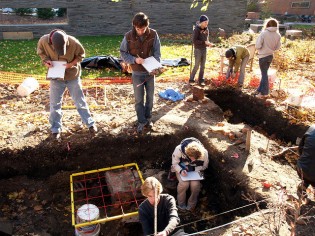The Hamline Village History Project is an ongoing collaborative public history project focused on the early history of the Hamline neighborhood. We are a loose affiliation of people and organizations, including the Hamline-Midway History Corp, Hamline University (especially our archives staff), and a variety of local history enthusiasts, genealogists, and architectural historians. Our goals include helping develop our neighborhood identity through a better understanding of local history and providing educational opportunities for students and interested members of our community through direct participation in excavations and other research.
My role in this project is primarily through teaching my ANTH 3130: Excavating Hamline History course. My first class was in the fall of 2004 and was intended as part of Hamline University’s Sesquicentennial anniversary. That first fall my class excavated Hamline’s original Hall of Science, a massive three-story red brick

Hall of Science ~1902 (Hamline University, collection.mndigital.org)
building erected in 1887 and demolished in 1971. The Hall of Science clearly played an important role as one of the defining institutional centers of the early Hamline community. For example, the first intercollegiate basketball game was played in the Hall of Science’s basement back in 1895. The building also held one of the region’s earliest natural history museums. I remember reading a news story in the school paper about the local excitement over an exhibit of gorillas (presumably stuffed) from the museum’s early years. More importantly, as the third building constructed on campus, and the first dedicated solely for instructional purposes, the Hall of Science demonstrates Hamline’s early commitment to teaching science as an essential part of a university education.
Our 2004 excavation uncovered an intact foundation and corner of the building. One of the more interesting artifacts we found was a marble “H”. We at first thought this “H” was  from the “Hall of Science” name plate over the door, but after reviewing the photographic record, we realized this fragment is from Goheen Hall which was torn down just one year earlier. We also recovered mundane artifacts like window glass shards along the building’s front and bottle glass shards along the back of the building. While this distribution of glass may seem unimportant, it actually showed me that the archaeological record of the Hamline neighborhood has real patterns. It’s not just a continuous smear of 19th and 20th Century artifacts. Instead there are distinctly different archaeological records preserved throughout this historic landscape.
from the “Hall of Science” name plate over the door, but after reviewing the photographic record, we realized this fragment is from Goheen Hall which was torn down just one year earlier. We also recovered mundane artifacts like window glass shards along the building’s front and bottle glass shards along the back of the building. While this distribution of glass may seem unimportant, it actually showed me that the archaeological record of the Hamline neighborhood has real patterns. It’s not just a continuous smear of 19th and 20th Century artifacts. Instead there are distinctly different archaeological records preserved throughout this historic landscape.
The Hall of Science dig convinced me that employing a landscape archaeology prospective will bring real insight into our understanding of Hamline neighborhood history. We excavated a variety of sites over the next several years including the remains of a fire-destroyed church, a short segment of oxcart trail, foundation stones from the original University Hall (the one destroyed in 1882), and even a World War 2 era trash pit from the backyard of a Hamline neighborhood house. Each one of these excavations added new insight into the history of our school and this community.



Recent Comments